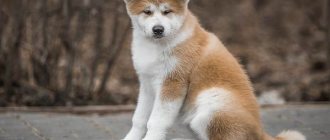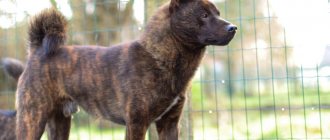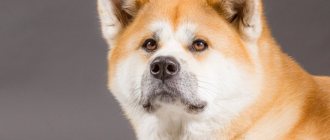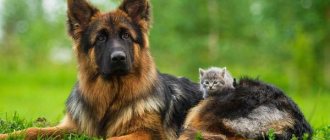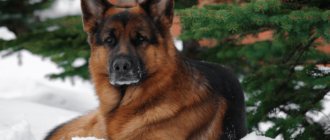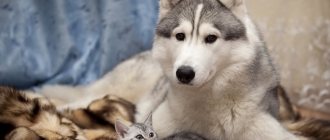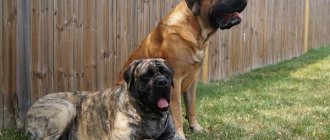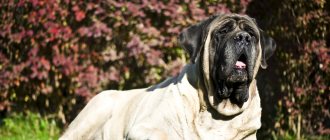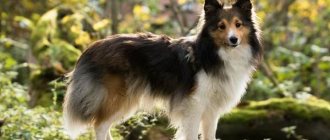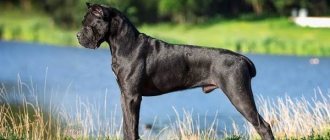An Akita Inu dog that resembles a cute plush toy can capture your heart forever and become your best friend for life.
This beautiful, graceful breed has conquered the whole world not only with its appearance, but also with the rich inner world of its representatives.
This breed became especially popular thanks to its famous representative named Hachiko.
In this article we will look at what one of the top dogs in the world looks like.
Description and features
The Akita Inu breed is one of the top 5 oldest. It is believed that its representatives inhabited the planet before our era. Even the Hellenes, the ancient people of Greece, depicted these beautiful animals on the walls, painting them or carving them on stone. This dog was originally domesticated by hunting peasants.
They liked her due to her attractive appearance, agility and speed. People realized that they were dealing with a very capable hunter. And they were right. Until now, Akita is actively used by forest hunting enthusiasts to hunt various animals.
The rapidly growing popularity of the beast could not but go unnoticed by the rich nobility and even the Emperor of Japan himself. Breeders began to breed him. After this, an ordinary villager could not afford to purchase a high-quality representative of the breed.
Interesting! In Ancient Japan, the emperor issued a decree prohibiting harming the Akita Inu. Corporal punishment against such a dog was strictly punishable.
This is a truly unique breed, because it was formed by nature, without selection. That is, it does not have the genes of other dogs. The dog has not yet lost its sacred status. In the 20th century, people even created a society to preserve its species. This handsome hunter is also a companion. He likes people and some animals, so he happily makes friends with them.
The main characteristic of the Akita is loyalty. It is difficult to name a more loyal pet. He always shows trepidation towards his owner, is sincerely afraid of separation from him, and strives to always be near him.
Very vulnerable. Afraid of criticism and reproach. It suffers when a loved one moves away from him. Therefore, if you do not plan to regularly spend time with your pet, avoid purchasing a representative of this breed.
In the photo there is a dog of the American Akita breed, different from the Akita Inu in height, weight and body proportions
He has one more purpose - watchdog service. Such a dog can be not only your friend, but also your bodyguard. He cares about the peace of his family. Who is this pet suitable for? We recommend starting one for people who like sports and outings.
You will have to walk your Akita often, and not only in the vicinity of the house. She needs to regularly replenish her stock of emotions and gain impressions.
Akita Inu is responsible for guard duty, but will never bark without a reason
Breed standard
The Akita Inu dog is a medium-sized dog. Bitches weigh up to 35 kg, and males - up to 45. A slight overweight is acceptable. The height at the withers of the former is up to 64 cm, and the latter – up to 71 cm. The animal has a strong and harmoniously built body. Straight back without bends. Strong muscles run along its length, but due to the dense fur they are not visible. The ribs on the sides are also not visible.
The sternum is well developed. It does not stick out, but is quite wide in volume. Strong elongated neck with slight dewlap. The transition to the head is weakly expressed. The tail is fluffy, long, rounded with a ring. According to the standard, it should lie on the lower back. The Akita has very powerful hind legs.
Thanks to the elastic, dry muscles that run along the thighs, the animal is able to push off strongly from the ground and quickly increase speed. The forelimbs, like the hind limbs, are set parallel. A special feature of this breed is its soft paw pads, like those of cats. The knuckles should stick out on them. The claws are dark.
The dog's skull is wide, the head is shaped like a triangle. Eye set is average. They should not stick out or be planted too deep. The color of the iris is brown or dark brown. The nose of a representative of the breed can only be black. But in light-colored individuals, slight pigmentation is allowed on this part of the head. The dog's ears are erect. They should be miniature and slightly rounded at the ends.
The skin does not fit very tightly to the body; in some areas, for example, on the neck, there may be folds. The coat is medium in length, very lush and thick. There is an undercoat that is delicate and soft to the touch. The standard allows for a lot of variations in the fur color of such a dog. It can be piebald, brown, sandy, pure white, reddish, etc.
If the individual is light-colored, then its front part of the body, or rather the chest and the tip of the muzzle, should be pigmented white. Important: the standard allows for differences in shades between the undercoat and the main coat. The Akita Inu in the photo looks interested and very smart. There is insight, foresight and intelligence in this dog's gaze. He undoubtedly deserves respect.
The most common colors of Akita Inu
Character
The representative of the breed fully corresponds to the “typical Japanese”. He absorbed all the character traits of a classic representative of the Eastern world. By temperament he is a mixture of melancholic and phlegmatic. Most often, calm, restrained in emotions. He is not prone to violent expressions of delight, but sometimes still demonstrates strong emotions to others.
Due to the presence of protective qualities, he is reserved with strangers. He treats most strangers without trust. Sees them as potential troublemakers for his family. He can openly express his antipathy to a person he doesn’t like, for example, come up and kick him with his nose, offering to move from his place. Yes, such a gesture may seem rude to many, but you shouldn’t get hung up on it.
Akita Inu is not evil by nature, on the contrary, it is a very kind dog. Around his family he is friendly and very affectionate. Loves to sit near the owner or walk with him. Does not tolerate separation, prefers never to be separated. It suffers and becomes melancholy if it does not see its owner for a long time. You may even lose your appetite because of this.
There is no activity for such a dog. He is active and playful. He loves to fetch a ball, run distances after it, swim in the river and just walk. If you cannot regularly take him to the forest for hunting or forays, we advise you to enjoy long walks. Even older people will not refuse to walk through the park.
Akita Inu prefer long, exciting walks for walks.
The representative of the breed has an interesting feature - he strives to base relationships with people on a strong emotional connection. Never ignores the person he loves. Can silently express sympathy for him, share joy, listen, etc. Perfect for providing psychological assistance. There is even a separate direction in psychotherapy (canistherapy), which consists of providing suffering people with help from their four-legged pets.
This dog has a clear desire for dominance, which is why it is not easy to train. You need to try to earn his trust. He will only be imbued with respect for a person with pronounced leadership potential. It is to him that he will serve faithfully for the rest of his life. He perceives everyone else as comrades and companions, but not his masters.
Gets along great with kids, especially very young ones. He watches them with interest and often shows responsibility. Protects and prevents children from being hurt. Can be used as a nanny. But you shouldn’t place too much hope on your pet in this regard!
Akita Inu's attitude towards cats is not as welcoming as towards children. He does not like these animals, and he also treats birds with distrust, and often with anger. Perhaps this is due to its guarding and hunting qualities.
Akita Inu is a very obedient dog breed and will be friends with all family members
But, if you raise such a dog together with other pets, then it is likely that they will become friends. Joint socialization always brings people closer together. This amazing breed is famous for having a strong will. No one can say that its representatives are stupid or weak in spirit. It is extremely difficult not to respect them.
Care and maintenance
It is better to live with an Akita Inu in a large house, with a lawn, flower beds and a terrace. There she will have plenty of space to engage in physical activity. Hunting dogs living in houses, in the fresh air, are much happier than those living in apartments.
However, you should not think that since the animal is often outdoors and interacts with the outside world, it is not necessary to walk with it. Every pet needs new experiences, especially dogs. The main command that such a dog should know is fetch. Let him bring a stick every day.
This is a very useful exercise. Firstly, it strengthens the emotional and spiritual connection between the owner and his dog, and secondly, it has a positive effect on its health. Sport should become an integral part of the Akita's life. A representative of this breed will always remain beautiful if you take proper care of its coat.
It needs to be washed, dried and combed. For bathing, we recommend choosing a good shampoo with vitamins and healthy extracts. After you have given your dog a good bath, dry him off with a towel. It will shake off the remaining moisture on its own. Then use a hairdryer to dry his lush coat. If the procedure is performed in the summer, then this is not necessary.
Also teach your pet to brush its teeth regularly. This procedure must be performed by 2 people. One holds his mouth, and the second brushes his teeth. And last but not least, cleaning your ears. It is better to remove sulfur on their surface with a damp cloth.
How to choose a puppy?
If you decide to get a dog of this breed, it is best to contact a kennel that specializes in this particular breed. It will be even better if this club or kennel is recognized by the International Canine Organization.
When choosing an Akita Inu puppy, you should consider the following points :
- Choose a puppy from a small litter where all puppies are approximately the same size.
- It is important to familiarize yourself with the pedigree, to study whether there are any genetic diseases or allergies. You should not take puppies from parents who were closely related - this increases the risk of diseases in the puppy.
- By talking with the puppy’s parents, you can roughly understand the psychological portrait of their offspring.
- When communicating with a puppy, it is important to pay attention to how much he makes contact and is interested in the potential owner - if all this is present, then the puppy is ready for a new family.
- Are there any external flaws in the puppy, how active and playful is he, is there an unpleasant odor, are all his teeth and claws intact.
Nutrition
Make sure your dog does not gain excess weight. Being overweight is fraught with impaired digestive function, body asymmetry and poor health. For an adult representative of the breed in question, the daily dose of food is 600 grams. Give him the opportunity to eat twice a day, for example at 9 am and in the evening, closer to sunset.
The younger the dog, the more protein it should consume daily. Feed her dairy products, raw meat and cereals boiled with vegetables. It is advisable to add special vitamins to your dog’s food. We recommend that you consult your veterinarian first. He himself will select the supplement your pet needs.
Advice! The best complementary food for purebred dogs is bone meal. This is a very useful product, the use of which will significantly improve their health.
Akita Inu puppies , like adult representatives of the breed, can eat dry food. But, it is advisable to dilute their diet with natural food. Recommended products: cottage cheese, chicken eggs, turkey, buckwheat, bananas, etc. But you can’t give them smoked meats and dishes with spices.
Brindle color
The Japanese husky with a tiger skin is still exotic for Russia, but in the historical homeland of the animal it is now the most popular. There are several varieties of this suit:
- Blue,
- White (with very light stripes),
- Black (also divided by degree of saturation),
- Redhead.
For a long time there was debate about whether stripes on the head were acceptable, and, ultimately, they came to the conclusion that it was better without them.
To read: Charming white dwarf Pomeranian spitz: recommendations for caring for your pet
In the red version, paler shades are appreciated, while deep red is undesirable. The most prominent and valued judges at international exhibitions are black and salt and pepper.
Reproduction and lifespan
The lifespan of an Akita Inu depends entirely on how conscientiously the owners take care of it. A dog can live a long and happy life, but only if it is, firstly, fed properly, secondly, given vitamins to improve the condition of the coat and strengthen the immune system, and thirdly, if you regularly exercise with it .
Average life expectancy is 13 years. It is easy for a breeder of this breed to distinguish it from any other, because the Akita Inu has a unique, distinctive appearance. Dogs are bred on neutral territory and only during the female's menstrual period. If conception is successful, she will go into labor approximately 70 days after mating with the male dog. It is advisable to invite a veterinarian to the birth process.
Origin story
The breed of these brindle-colored dogs has an ancient history and originates from Japan. The Japanese consider it their national treasure due to the purebred and large size of the dogs. This breed was noted in ancient sources 8 thousand years ago and was first bred on the Japanese island of Honshu, in Akita Prefecture.
NOTE!
Initially, dogs of this breed were of medium size. But gradually they began to be crossed with other breeds and used for dog fighting, due to which their size increased.
The ancestors of modern Akita Inu are considered to be the Chinese Spitz breed and mastiffs. Akita Inu are one of the 14 oldest dog breeds .
Initially, brindle Akita Inus were used by humans as hunting or guard dogs for their impulses to protect their owner and fight with any living creature.
Over time, the hunting status of dogs grew into an elite one, so only wealthy segments of the population began to acquire representatives of this breed.
These dogs became widespread after World War II, and are now available in Europe and America. On the basis of this breed, the United States even bred its own American Akita. The breed standard for the brindle Akita Inu was approved in the USA in 1982 .
Price
Not everyone can become the owner of a high-breed Japanese dog, since it is quite expensive. There is a nursery in Moscow where purebred Akita Inus are bred. For each puppy they issue a full package of documents, including a passport and pedigree. When making a purchase there, you can be sure that you are not getting a “pig in a poke.” The average price of an Akita Inu in the Russian Federation is 50 thousand rubles. Adult champions are sold at a higher price, 60-70 thousand rubles.
Education and training
This perky dog can become a good student, but you should not count on him to always be obedient. No, he is willful and prone to demonstrating leadership, which is why he should be trained by a person with a similar quality.
It is important to show the animal that in this house it is not he who is in charge, but the person. Therefore, he will have to play the role of a subordinate. To achieve this, we recommend feeding your dog by hand. This way she will understand that you control the food and therefore are in charge. You also need to demonstrate your primacy during training. Teach your pet obedience from childhood.
You can yell at him if he does something inappropriate, like chewing on his shoes. But, never raise your hand to him! Monitor your dog’s communication with other household members and animals in the house. He should not show any signs of aggression. If an Akita Inu growls, remove it, for example, by locking it in an enclosure. Don't try to calm him down by stroking him!
Teach your dog to follow simple and complex commands, gradually increasing the duration of training. When going for a walk with him, keep the leash tight. When your pet gets used to being guided by you and stops pulling, you can give him freedom. Avoid walking near the roadway.
Akita Inu white
This suit is today recognized as the rarest in Russia, but often found in Japan. And it appeared relatively recently, only in the first half of the twentieth century. An important condition is the absence of any, even the tiniest spots, and also the lips and tip of the nose are visually outlined; they should be as dark and clear as possible.
A light nose is acceptable provided that the outline of the lips and around the eyes is contrastingly dark. The purity of white also plays a big role in the evaluation of a pet at shows. Acceptable, but still a drawback is the presence of a yellow or gray tint. But a light touch of blue will only add points and is considered ideal.
Possible diseases and methods of treating them
Akita Inus are healthy and cheerful dogs. Unfortunately, they are often bothered by parasites, especially fleas. This primarily applies to individuals living on the street. To prevent your pet from encountering the problem of parasites, treat its fur with special drops or spray.
It is important to follow the instructions. It would also be a good idea to consult a doctor about deworming medications for your dog. Due to the abuse of natural food, his digestion may be upset. In this case, diet and gradual normalization of the diet will help.
Sesame
Sesame-colored Akitas are a real rarity in modern cities, although they were common in the mid-20th century. A distinctive feature of a dog of this color is the presence of a red mantle with black braces on the back and a white lower part of the body. Currently, the sesame color of the Akita Inu is never involved in selection, so in Japan it is losing popularity, and in Russia it is almost completely dying out.
Photo from Instagram account nana_akita_inu
Sesame-type coloring is a subtype of red coloring, along which dark black inserts spread. They represent a darkening, a coating different from the main color of the coat of a purebred dog. Additional characteristics of the shade are determined based on the ratio of hairs of black, red, bleached type.
There are two subtypes of sesame - red and black, and only uniform blackening of the body hair is accepted. A dog will be considered culled if there is a saddle cloth on its face. This color, however, is approved by international specialists, but is not considered acceptable on Japanese territory. However, for the last few years this type of color has practically not been found.
